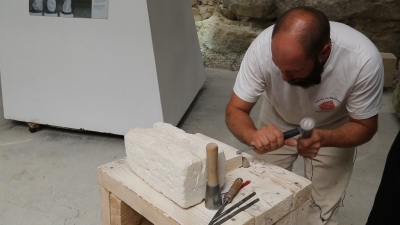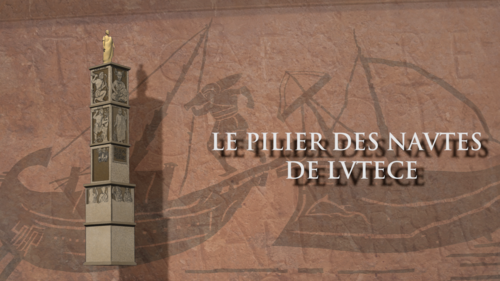
History enthusiasts set up a challenge:
building back up the oldest monument of Paris !

This pillar is the oldest Parisian monument known (dating to the beginning of the first century AD). Its vestiges (incomplete and damaged), discovered in 1710 beneath Notre-Dame cathedral, are displayed now at Musée de Cluny (Musée National du Moyen Age). Its sides show the encounter between Celtic and Roman cultures, which fought each other then mixed before disappearing.The sculptors work give away evidences on Gallo-Romans life in their full prosperity, particularly thanks to trading relations with the Roman Empire, in the early days of the Pax Romana.
It depicts Celtic and Roman deities, in a monumental ensemble dedicated to Emperor Tiberius by the boatmen of Lutetia (Lutèce). The 4 blocks of limestone assembly, carved on 4 faces ( a base and a possible statue atop), was 5 to 6 m tall and about 80 / 100 cm at its base. Its location was probably on the Ile de la Cité, near the ancient port site. It should strike visitors coming to see the Gallo-Roman city, its districts and monuments (theatre, amphiteatre, forum, Roman baths...).

Aim: a replica at the scale 1 and erected in Paris on the bank of the Seine!
The reconstruction combines artistic research (other monuments and antiques representation), scan and 3D modeling jobs, and experts group's hypotheses (from Historians, geologists, archeologists and museum curators). According to certainties and interpretations, all or part of decorations would be carved, the base defining the approach and hypothetical nature of the sculpture.
Being intented for a public display, this reconstruction would come along with multimedia contents (web and mobile) to explore and understand the monument with its context and offer to visit the ancient city of Paris. The contents would be shown at the base of the sculpture also used for a touring exhibition.
A joint initiative of researchers, a film-maker, associations, a broadcast and digital agency, institutions and private individuals, passionate about Paris heritage.
3D scan permits to explorate in depth the surface of the pillar vestiges. In association with the 3D laser scanning department of the Réunion des Musées nationaux, we use this process revealing some useful aspects to our « autopsy » of the monument and its reconstruction stages.

RECONSTRUCTING THE FACES OF THE DESTROYED MONUMENT
Most of the pillar faces are incomplete and some are greatly hammered. Comparing several deities representations found in France and in Europe, the reproduction, firstly virtual, would combine several digitisations to offer some close shapes to a possible ancient form.
Combining materials with ancient and modern techniques, we offer you, as a challenge, to contribute to the reconstruction of this pillar, as its more probable ancient shape.
The expected 6000 euros fund-raised would allow to launch the project, respecting an historical tapproach to end in a first 3D model of the monument and evaluate its transition to stone.
STAGE 1 : STUDY AND 3D DESIGN
Budget : 6 000 euros
1/ Document research about the pillar and its discovery
2/ Comparative research with other Gallo-Roman monuments
3/ Exploiting the 3D scanning of the existing items
4/ Designing a 3D model, highlighting sides and faces
5/ 3D printing of the sections in resin or other material (helping to carve it later on stone)
6/ Sculpture test on Oise stone
Thanks to your contribution, if this collection step is exceeded, we would start the transition process to stone, following the footsteps of the ancient sculptors, to begin to rebuild the pillar.

A possible location for the future pillar
STAGE 2 : CONSTRUCTION
budget being evaluated
1/ stone type identification and search for blocks extracted from quarries
2/ stone blocks carving (motifs and inscriptions)
3/ (option if there is a discovery leading to it) painting/polychromy of figures
4 / assembly of items on the base and layout on site
5/ installation of the Nautes’ pillar in a dedicated parisian site
6/ multimedia design
7/Reproduction at scale 1 in resin for touring exhibitions
A multimedia touch screen totem to discover Lutetia
On the pillar base, a tag and a panel show the possibility of connection to get information about the work (3D model to see the sides, origins and function of the pillar, history of Lutetia…).
- To donate online through this page, after getting registered: ww.dartagnans.fr
- by bank transfer order, through this page, after getting registered: www.dartagnans.fr
- or sending a cheque payable to the association Gladius scutumque), along with your e-mail, to the following address:
Dartagnans
Campagne Les Piliers des Nautes de Lutèce
14 rue Crespin du Gast
75011 Paris France
Special website:
http://www.pilierdesnautes.par...
Facebook : https://www.facebook.com/group...
Our association : GLADIUS SCUTUMQUE


Non profit association (under the French Law of 1901) of re-enactment and living-history, focused on urban life in the Gallo-Roman age. Based in Paris, it contributes to study the founding of Lutetia and its historical context. It has a network of friendly associations dedicated to several periods of History (Gallic, Middle-Ages…) sharing experience, during meetings in France and abroad.
Members and supporters are coming from very diverse professions and degree courses. They swing into action to give to this project a scientific and cultural scope. The purpose is to communicate about the ancient heritage of Lutetia that can interest the Parisian people (adults and children) as much as the numerous tourists visiting the capital of France.
Facebook : https://www.facebook.com/group...
Archéologia (article in the November 2017 issue)
Several partners and consultancy agents are helping us to build up this project, including:
- Maison de la pierre de l'Oise (Stone quarries of South Oise)
- Réunion des musées nationaux (scan 3D)
- Séquana média (documentaries production, 3D reconstructions)
Many thanks for your participation.
By supporting this project become, like the Lutetian
Boatmen, sponsors of the oldest monument of Paris!